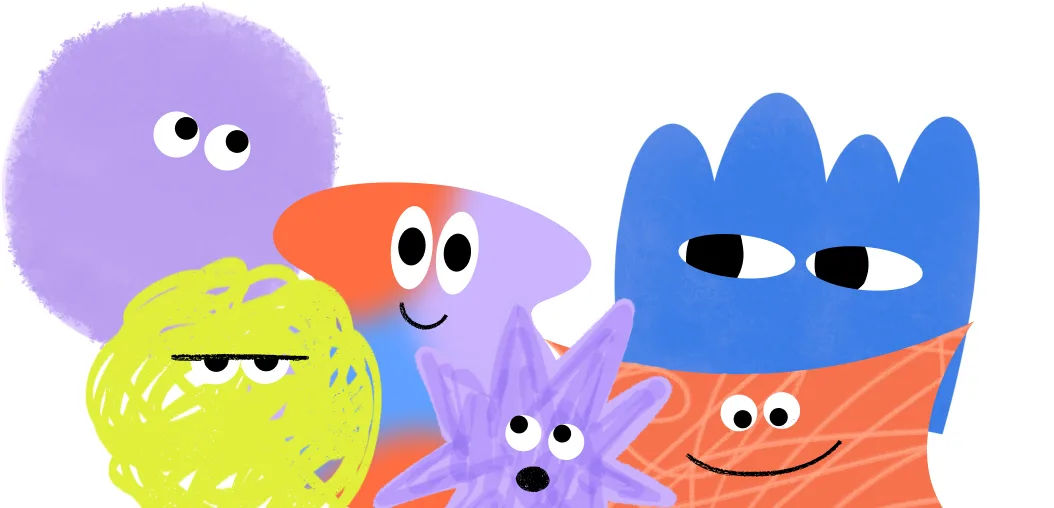
Better Hearing and Speech Month: 31 Day Language Challenge
 Leanne Sherred, M.S., CCC-SLP
Leanne Sherred, M.S., CCC-SLP
May is Better Hearing and Speech Month! Below is an activity for each day this month that will help stimulate your child’s speech and language skills! These activities are meant to be short and simple exercises that you can naturally incorporate into playtime routines or everyday interactions with your child.
Day 1: All aboard!
Today, we’re starting off with a movement activity for modeling all kinds of interactive vocabulary! Pull your child around in a laundry basket or on a blanket and model the following:
Descriptors (fast, slow)
Actions (stop, go, sit/lay down)
Locations (up, down, around)
Fun sounds (wee! whoa!)
Day 2: Knock knock! Modeling object labels
For this activity, use items from around your home to make a Knock Knock box! The excitement and anticipation around the box can help your child tune into the names of the objects as you label them. For more information, check out Expressable Academy’s lesson on object labels.
Here’s how to play:
Take a box with a lid (make sure your child can’t see inside) and put small toys inside
Say, “Knock knock!”
Playfully take out each item one by one, and label it!
Day 3: Play bubbles to practice turn-taking
Practice simple turn-taking while playing with bubbles to help build foundational skills for back and forth communication! For more info, check out Expressable Academy’s lesson on playing with bubbles to promote turn-taking.
Blow a bubble, then wait for your child to respond.
A response can be a word, sound, smile, or gesture.
Go back and forth as many times as you can.
Day 4: Give choices during mealtime
By offering choices, you can set up opportunities for your child to communicate with you! Offer choices to encourage your child to communicate by:
Hold up two choices.
Label each one. “Do you want milk or juice?”
Wait expectantly for a response. A response can be a word, sound, look, or gesture.
Day 5: Sing a fill-in song!
Songs have the power to help your child tune into words. By adding a pause, you can set up a chance for them to sing along and practice using their words, sounds, or gestures too! Pick a part in your child’s favorite song where you will pause every time. When you pause, you help your child:
Know when it’s their turn to fill-in the word, sound, or gesture.
Take a turn with you!
Day 6: Model action words while building
Action words can be “building blocks” for creating phrases and sentences later! Build a tower with legos or blocks (big or small) and use the words below. Check out Expressable Academy’s lesson on turn taking games to learn more about how blocks can help teach language skills
Actions (Stack, Push, Fall)
Locations (Up, down)
Fun sounds (Uh-oh!)
Day 7: Teach language through movement
Today, help your child learn by doing! Repeat STOP and GO as many times as you can to help your child learn how to understand and identify different verbs. Examples of simple STOP and GO games include:
On foot: Hold your child’s hand. Say “Go!” and run together. Say “Stop!” before you stop running.
On wheels: With your child in a wagon say “Go!” and start pulling. Say “Stop!” right before you stop the wagon.
Day 8: Read a book with textures or flaps
Hands-on books help you model all kinds of vocabulary for your child such as action and texture words! If you don’t have this type of book handy, a DIY book can work too: Staple paper or cardstock together and glue different textured materials onto the pages. Talk about the following vocabulary during hands-on book reading:
Actions (Open, Touch, Look, Pull)
Textures (Smooth, Rough, Shiny, Squishy)
Day 9: Model actions & directions with an obstacle course
Running an obstacle course gets your child moving and learning about language concepts such as actions, location words, and stringing together directions! Build a simple (or elaborate) obstacle course in your living room with:
Cushions (to climb on or around)
Chairs (to crawl through)
Puzzles or stackables (to complete on the way to the finish line)
Day 10: Encourage imitation through mirror play
When you play in front of a mirror with your child, you help them see how your mouth and face moves when making sounds and expressions. This can encourage your child to imitate you! Make silly faces and sounds in front of a mirror with your child and learn more about verbal imitation at Expressable Academy.
Fun sounds (raspberries, animal sounds)
Silly faces (tongue out, wiggle side to side)
Babbles (bababa)
Words (in slow mo, high pitched, low pitched)
Day 11: Model actions and words while cooking!
Model action and description words when preparing a meal or snack together. Talk about what you are doing in the kitchen with your little one. You can also give them simple tasks such as pouring ingredients and mixing for more hands-on learning!
Actions (Put in, Mix, Pour)
Description words (Hot, cold, sweet, salty)
Day 12: Model words related to nature
There’s so much to talk about while outside! Today, take a walk outside and gather items like rocks, leaves and flowers into a small bucket or basket. Describe each one using vocabulary like big, little, soft, and crunchy!
Nouns (rock, leaf, flower, stick)
Description words (big, little, colors, shapes)
Day 13: Practice back-and-forth play with tickles
If your child loves tickles, this is a great way to practice back-and-forth play. By waiting to let your child respond, you set the stage for them to take a turn during interactions with you! Check out more information on turn taking games like tickling at Expressable Academy.
Give a tickle, then wait for your child’s response
A response could be a smile, laugh, sound, or word
Repeat as long as your child is having fun!
Day 14: Practice saying names with family photos
By helping your child practice saying “Hi!” to loved ones in photos, they’ll be more likely to begin doing it in real life! Today, look at photos of family and friends and talk about them! Say their names, talk about where they live, and describe what they look like.
Day 15: Strike up the band with musical instrument
Musical instruments can help reinforce important language skills like making sounds, singing words, and turn taking interactions. If you don’t have musical instruments around the house, you can always improvise by making them out of old boxes or containers. Play with your child and practice:
Making fun sounds as you drum (e.g. bop bop bop)
Making sounds back and forth
Singing a favorite song
Day 16: Offer choices while getting dressed
By offering choices, you can set up opportunities for your child to communicate with you and learn everyday vocabulary! Do this during the everyday morning routine of getting dressed! Check out Expressable Academy to learn more about using choices to help your child say longer phrases.
Hold up two choices.
Label each one. “Blue shirt or green shirt?”
Wait expectantly for a response. A response can be a word, sound, look, or gesture.
Day 17: Get crafty and model language
There’s lots of language to learn when creating art together! If your child already says single words to you, model a phrase that’s one word longer. For example, if your child says “Blue!” you can reply: “Blue crayon!” You can learn more about modeling language and expanding the length of your child’s phrases at Expressable Academy.
Using paint, crayons, markers:
Make a craft or just wing it!
As you create your masterpiece, talk about actions (dip, color, paint, draw) and descriptors (colors, shapes, big/little).
You can also go back and forth making shapes and lines together.
Day 18: Talk about sounds
Today, you can work on building listening and vocabulary skills with your child by talking about sounds! Gather items that make different kinds of sounds, or listen for distinct sounds throughout the day. For more information about modeling language, check out Expressable Academy.
Say “I heard a sound! What is it?” and wait for your child to tune in, too.
Model the name of the object or go to where you heard the sound.
Day 19: Ready, set, throw!
Today, get active and practice vocabulary related to throwing items toward a target such as a box or laundry basket. As your little one is throwing objects, talk about the actions, location words, and nouns/pronouns below. Repeat as many times as you can for lots of practice.
Actions (throw, catch, go)
Location words (in, out, behind)
Nouns/Pronouns (my turn, yours)
Day 20: A big box of fun
You can target lots of language related to building and imagination with just a box! Build a structure to crawl into and/or play in using old cardboard boxes. Remember to model language at a level just above your child’s current language level. You can find more information on expanding your child’s language here.
Talk about:
The steps to build (open, fold, cut, draw windows, etc)
Location words (in, out, behind)
Actions (knock, crawl, hide)
Day 21: Pronouns in the mirror
Helping your child learn pronouns helps with building phrases and sentences later! When playing in front of the mirror together, practice the pronoun “me.” Learn more about singular and plural pronouns at Expressable Academy.
Ask “Who’s that?” and point to your child
Model, “It’s me!” while guiding your child’s hand to point to themselves.
Day 22: Let’s talk emotions
Help your child label their emotions to help build language and social-emotional skills. Find pictures from books or photos of people making different facial expressions. Check out more information on helping your child identify and express their emotions.
Model emotion words: happy, sad, mad, scared, surprised
Day 23: Problem solve with puzzles
Problem-solving helps build language and social skills, too! Model problem-solving language when completing simple puzzles, then wait to give your child a chance to figure it out.
“Hmm.. it doesn’t fit.”
“We need one more piece.”
“Let’s find the same shape.”
Day 24: Sing a song with gestures
We communicate using our words, expressions, and gestures. Singing a song with gestures helps your child focus on nonverbal communication skills. Sing a song with gestures that go with it. You can pick songs like "Wheels on the Bus," "Twinkle Twinkle Little Star," or make up your own. You can find more information on using body language here, as well as helping your child use gestures while singing songs.
Day 25: Comment on a favorite story or video
Today, try to build some back and forth communication around your child’s favorite story or video by commenting! As you read or watch with your child, make a comment about what’s happening, then wait for your child’s response. A response from your child can be a word, sound, gesture, or facial expression. Your comment can be:
A sentence
A sound (“Uh oh!” or “Oops!”)
A gesture (a shrug)
A facial expression (sad face, excited face)
Day 26: Practice descriptive language using a mystery bag
Texture, size, and shape words help your child build rich sentences and descriptions. Place items of varying textures and shapes into a pillowcase. Have your child reach their hand in the bag and feel the item before pulling it out. Talk about its texture, size, and shape once they pull out the item.
Day 27: Using everyday vocabulary to talk about groceries!
Help your child learn everyday vocabulary on your next grocery run. Be sure to praise your little one for all their help! Whether your child goes with you to the grocery store or helps you put groceries away at home, talk about:
Names of favorite items (e.g. milk, juice, bananas)
Descriptors (heavy, hot, cold, yummy)
Following directions (put in the fridge, take out the ____)
Learn about how everyday routines can help with building language skills at Expressable Academy.
Day 28: Have a dance party!
Help build vocabulary for movement and fun! Play a game of Simon Says but with dance moves! Simon says:
Wiggle
Shake
Hop
Twirl
Day 29: Model possessive pronoun: “My”
Today, roll a car back and forth with your child. Every time the car comes to you, hold the car and say “My turn!” before rolling it back. When you model a word like “My” you also help your child learn about taking turns. Read more about possessive pronouns here.
Day 30: Play dress-up
Build language and imagination through dress-up and pretend play. Take old clothing like hats, jackets, sunglasses, and costumes and make a dress-up box. Describe them (big, little, soft), talk about actions (put on, pull), or use them for pretend play. Bonus points if pets or favorite stuffed animals join in, too!
Day 31: Pick a favorite activity and repeat!
Repeat, repeat, repeat to help your child build their language skills. Choose your child’s favorite activities throughout the month, and weave them into your daily play routines! Speech and language practice shouldn’t feel so much like… well, practice. So have some fun!
How Expressable Can Help
Concerned your child isn't reaching age-expected milestones? Looking for communication support from a professional? Expressable is a national online speech therapy practice serving children and adults. We treat all major areas of communication and feeding, offer flexible hours including evenings and weekends, and accept most major health insurance plans. We’re proud to have earned more than 3,000 5-star reviews from our clients (4.9/5 average).
Our therapy model is centered on parent and caregiver involvement. Research proves that empowering caregivers to participate in their loved one’s therapy leads to better outcomes. That’s why we combine live, 1-on-1 speech therapy with personalized education and home practice activities for faster progress.
Communication is more than words. It’s how we share how we feel and show who we are. We’re here to help you or your child do just that.







